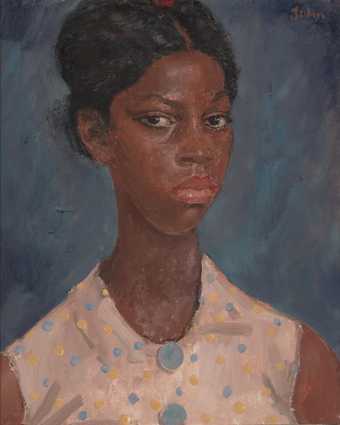
Augustus John OM, A Jamaican Girl 1937. Tate. © The estate of Augustus John. All Rights Reserved 2023 / Bridgeman Images.
Reality and Dreams 1920–1940
17 rooms in Historic and Early Modern British Art
British artists recalibrate their work in the aftermath of the First World War as they imagine how they could play a part in building a better society
The catastrophic impact of the war prompts many artists in Britain to change their work radically. Before the war, geometric and mechanised forms were seen as new, dynamic and exciting. However, in its aftermath, artists turn back to traditional genres such as portraiture, religious painting and landscapes. They term this mini revival as the ‘Return to Order’. More than revisiting old approaches though, this trend takes realism in new directions.
Younger generations react against pre-war values. They try to enjoy life to the fullest in the years known as the ‘Roaring Twenties’. Some artists portray women’s independence from traditional gendered roles. Others document the new diversity of London’s nightlife, as the city buzzes with new fashions, theatre productions and jazz brought from the United States by Black entertainers. Britain also enters a golden age of cinema and people flock to see new films.
However, this is also a time of depression, deflation and a steady decline of the British economy. By the mid-1920s, unemployment rises to over ten percent of the workforce in Britain. Declining industry leads to lower wages and increasingly bitter trades disputes. This culminates in a general strike in 1926. The Mass Observation research project documents working-class life during this period of economic decline. The Artists International Association leads artists’ opposition to a rise of fascism in Britain.
Surrealist artists are concerned with creating works influenced by dreams and fantasies. They create compositions that reject rationality and conscious thought through practices such as automatic drawing (drawing without thinking). The International Surrealist Exhibition in London in 1936 exposes younger British artists to the movement and encourages them to reimagine their work.
Sorry, no image available
Sir Jacob Epstein, Portrait Bust of Paul Robeson 1927–1928
1/30
artworks in Reality and Dreams
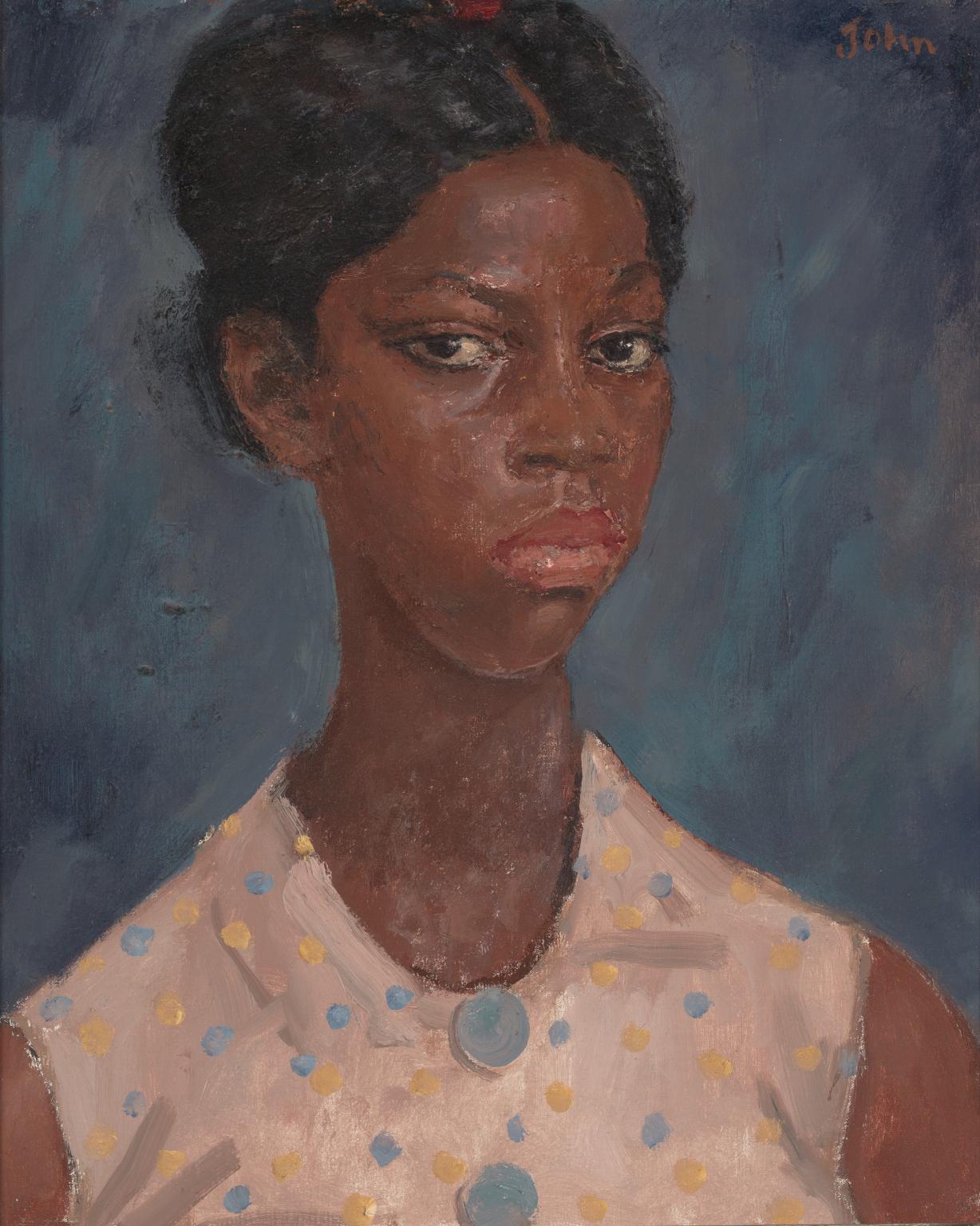
Augustus John OM, A Jamaican Girl 1937
2/30
artworks in Reality and Dreams
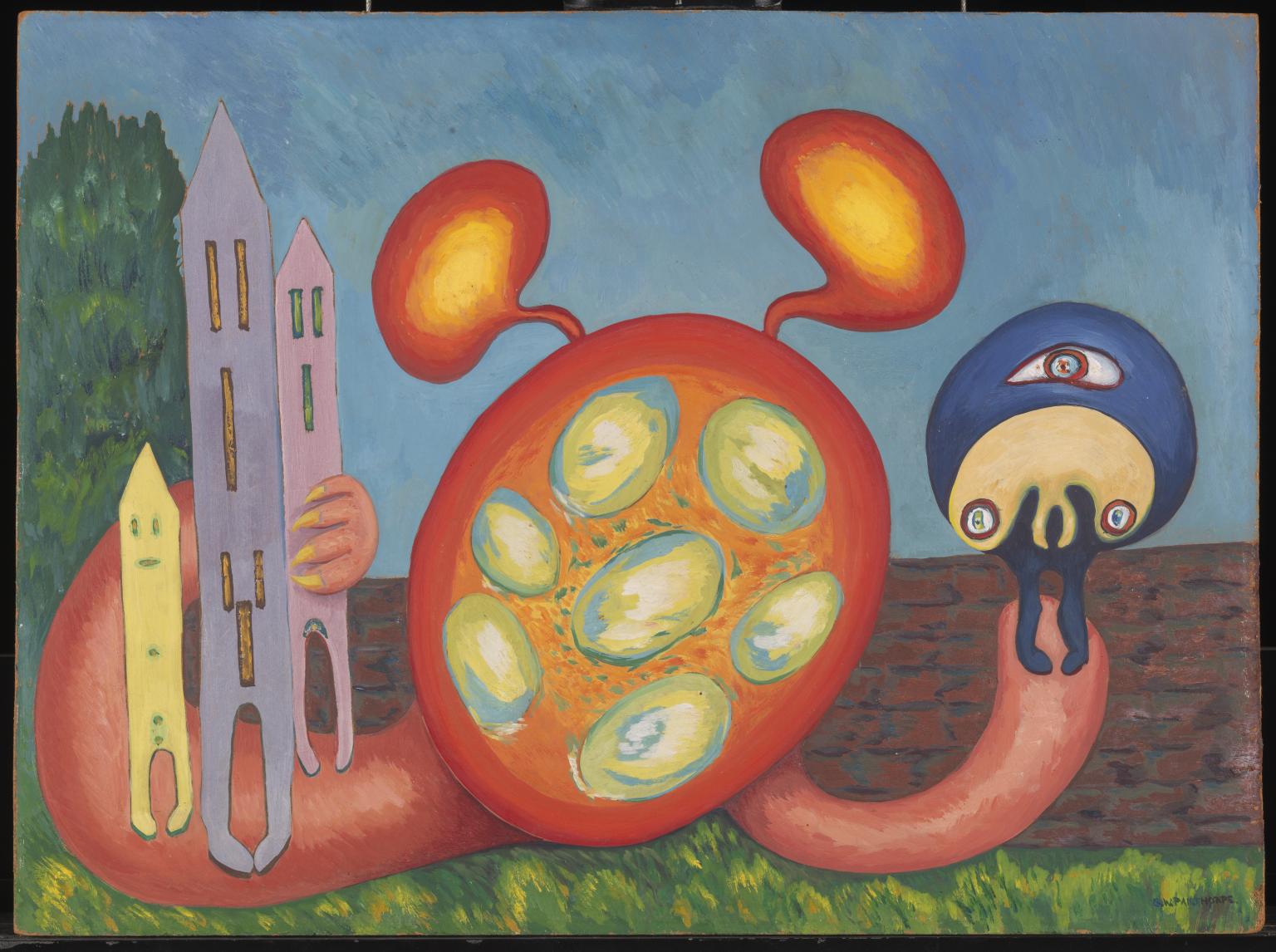
Grace Pailthorpe, April 20, 1940 (The Blazing Infant) 1940
3/30
artworks in Reality and Dreams
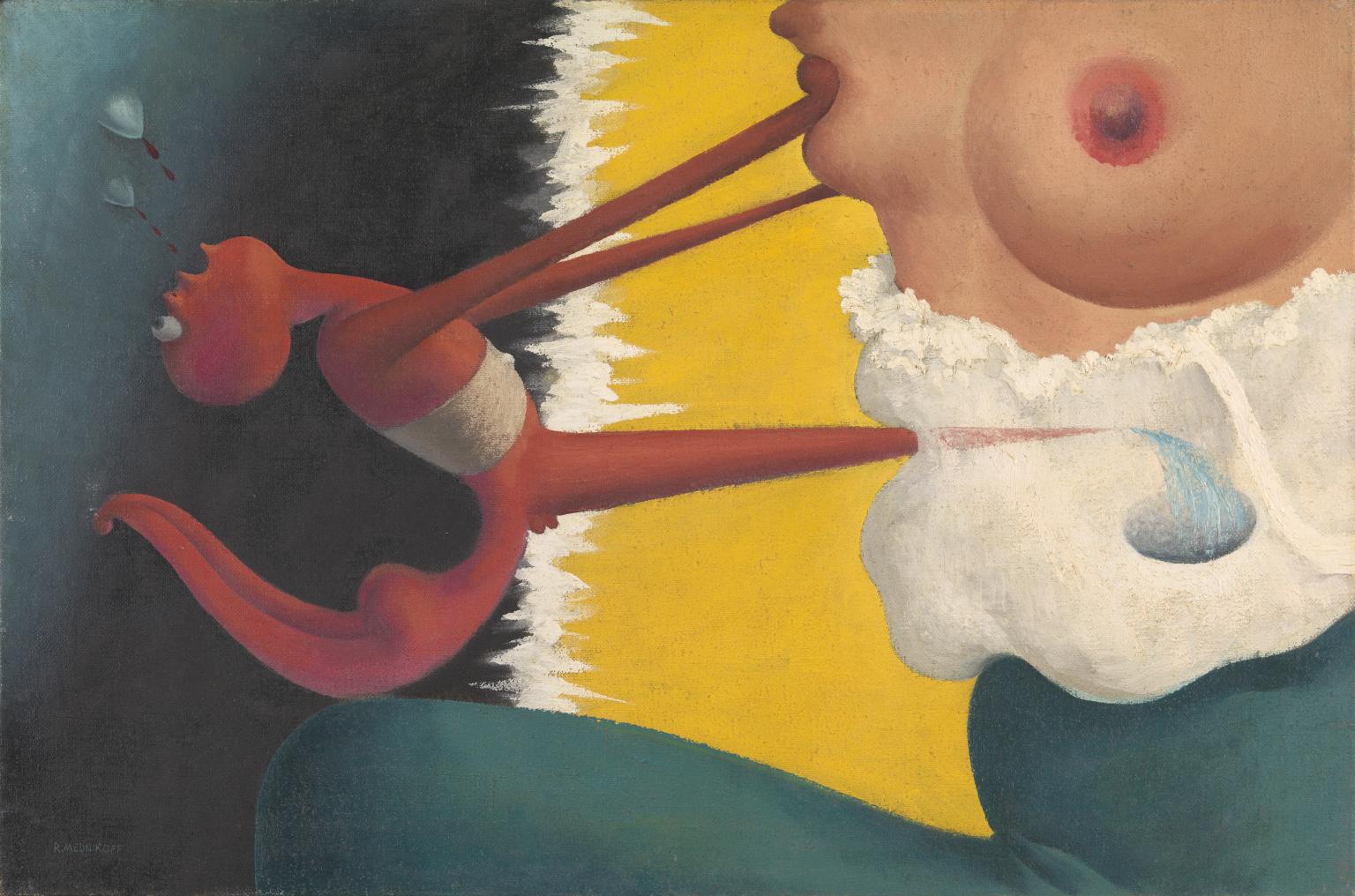
Reuben Mednikoff, December 31, 1937, 8.00pm (Oompah) 1937
December 31, 1937, 8.00pm (Oompah) is a landscape format oil painting on canvas. The background of the painting is divided vertically by a jagged white line – the right two thirds being a flatly painted yellow ground and the left third a dark blue-green. Represented against a yellow field is the semi-naked torso of a woman with breasts exposed, a white chemise under her breasts and her right upper thigh apparently clothed in a snuggly fitting dark fabric. Balancing on her thigh is a red baby or sprite figure with a white band around his waist. A long sharply pointed phallus penetrates and ejaculates through the chemise. His thin long arms reach out, holding onto and pushing against the woman’s right breast; his head arcs back, two drops of milk hanging above his open mouth. The work is titled after the date of its making, as was the artist’s custom, and while Mednikoff was living in Cornwall with his artist partner, Grace Pailthorpe (1883–1971).
4/30
artworks in Reality and Dreams
Sorry, no image available
Unknown artist, Tropic Reveries by Una Marson Date not known
5/30
artworks in Reality and Dreams
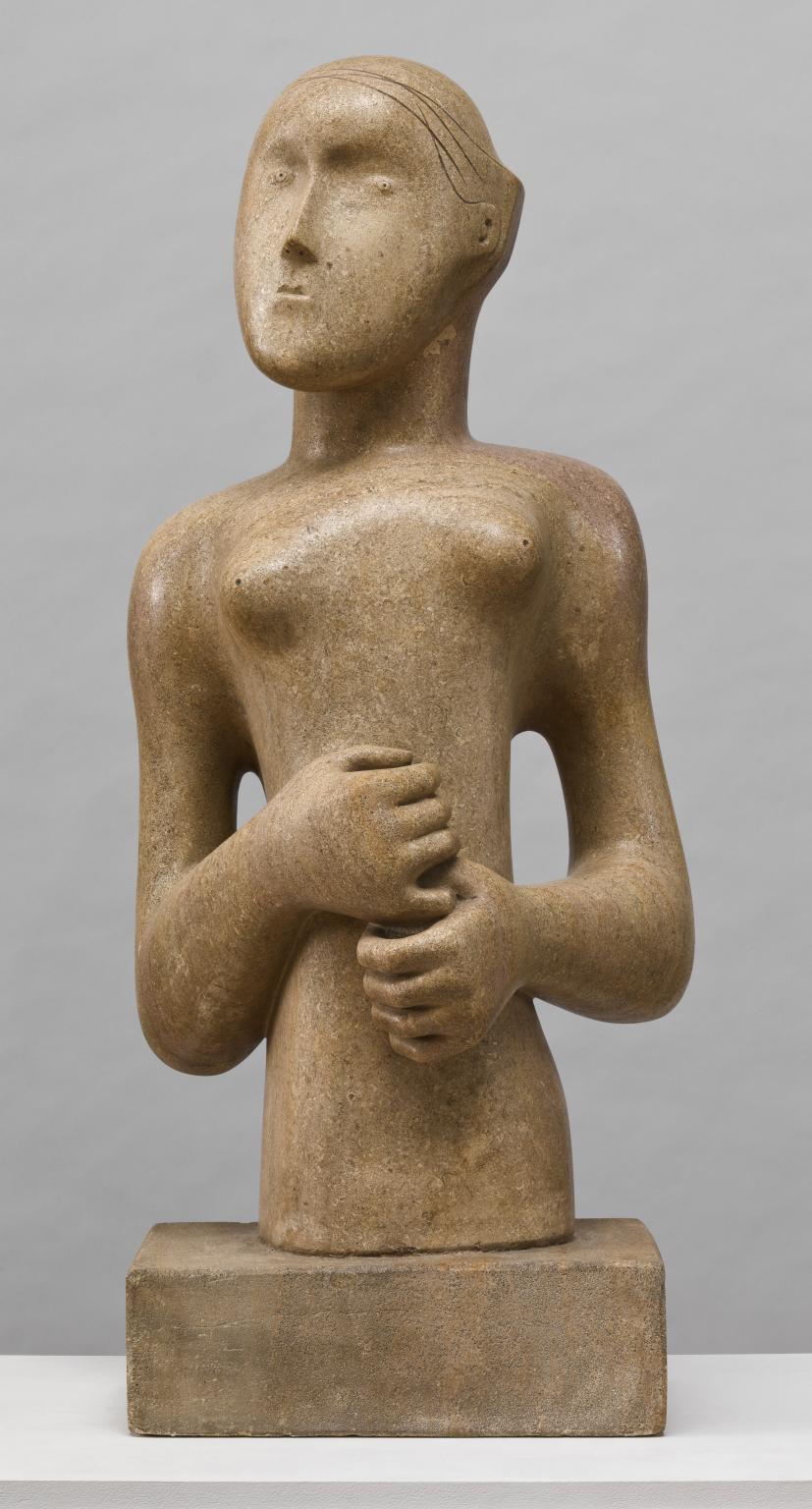
Henry Moore OM, CH, Girl 1931
From the mid-1920s Moore had advocated the abolition of the 'Greek ideal' in sculpture in favour of non-European sources, which he felt had much greater vitality. This work reveals his fascination with the Mesopotamian sculptures in the British Museum, especially solemn standing figures with clasped hands. He reviewed a book on Mesopotamian art for 'The Listener' in June 1935. Around 1931-2 Moore also turned his attention to the study of natural forms, such as shells, bones and pebbles. He then brought together his studies in natural forms with his admiration for non-European 'primitive' sculpture and began to introduce a rhythmic and non-naturalistic approach to the depiction of the human figure.
Gallery label, August 2004
6/30
artworks in Reality and Dreams
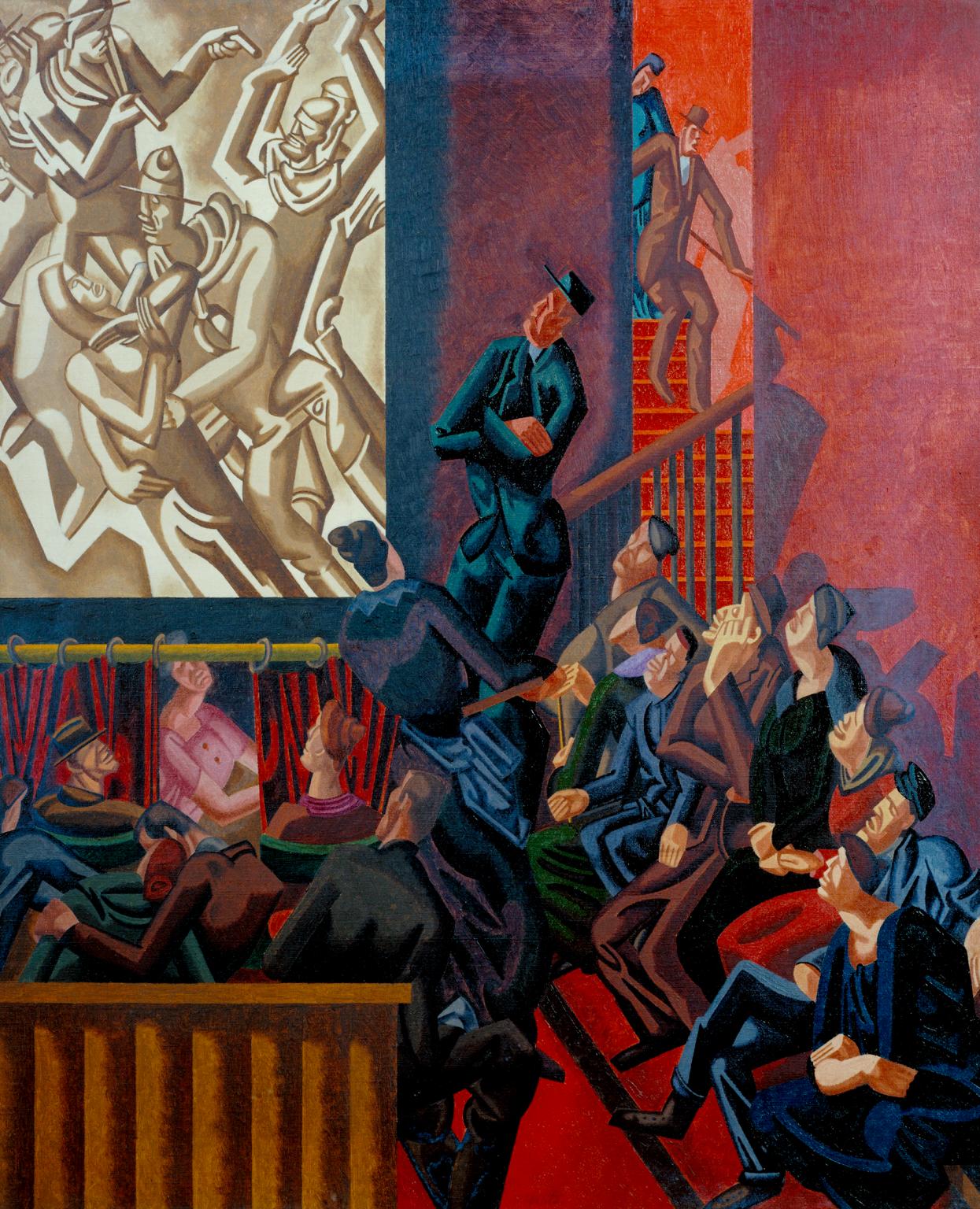
William Roberts, The Cinema 1920
Roberts’s early work was abstract and he joined Wyndham Lewis’s vorticist group. After the First World War, he made a name as the painter of everyday modern scenes. While film had been invented in the late 19th century, it reached new heights of sophistication and popularity in the 1920s, the age of Charlie Chaplin, Buster Keaton and the rise of Hollywood. Movies were silent until 1927 and were accompanied by live music. Many music halls, traditional places of popular entertainment, were adapted to show films.
Gallery label, September 2016
7/30
artworks in Reality and Dreams
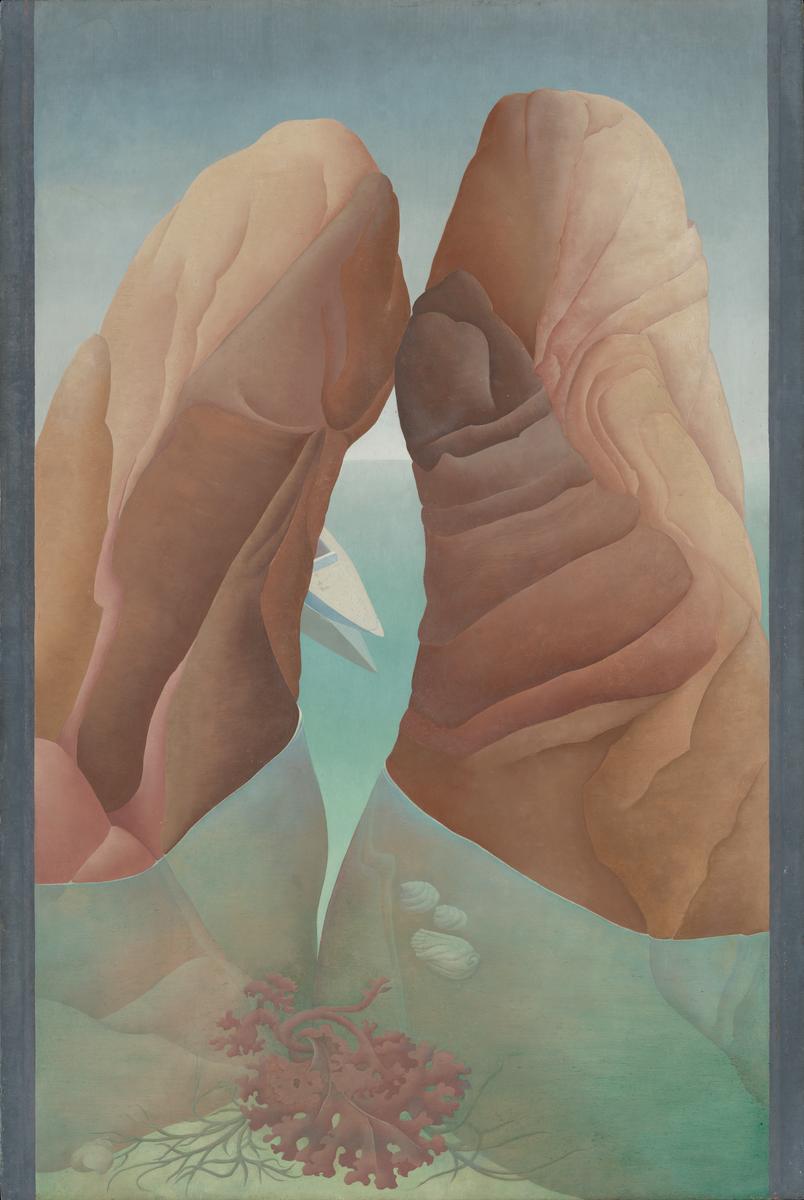
Ithell Colquhoun, Scylla 1938
The title of this work refers to the female monster who, according to ancient Greek mythology, inhabited a narrow channel of water and fed on passing sailors. Colquhoun explained that the image could be understood in two ways, both as a seascape and as an image of her own body. ‘It was suggested by what I could see of myself in a bath…it is thus a pictorial pun, or double-image’. The rock formations can also be seen as knees, with seaweed in place of pubic hair. This work was painted at a time when Colquhoun was exploring surrealist ideas such as the double image.
Gallery label, January 2019
8/30
artworks in Reality and Dreams
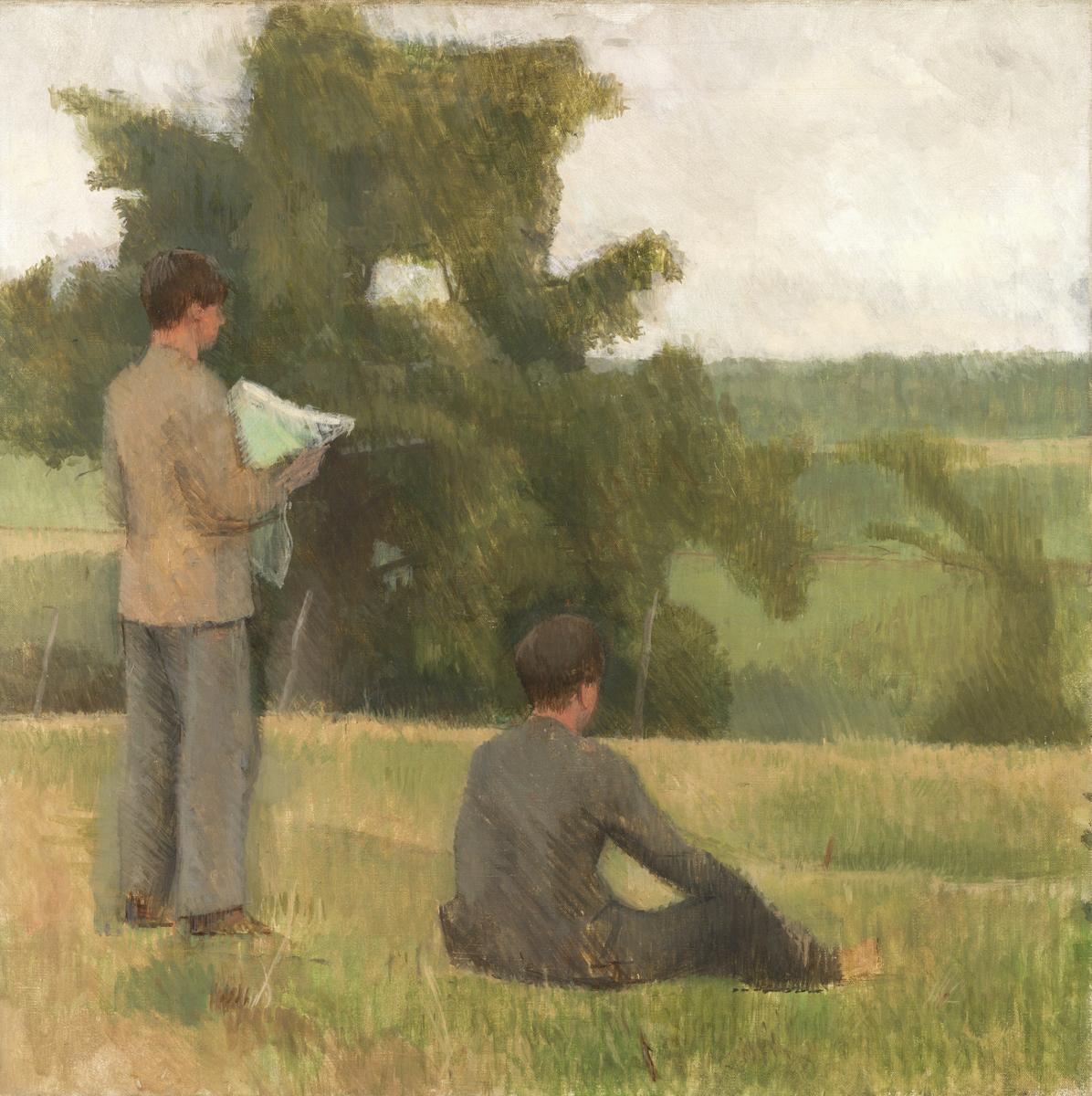
Sir William Coldstream, On the Map 1937
In this picture Coldstream shows fellow-artist Graham Bell standing holding a map, and his friend Igor Anrep sitting on the ground. Seen from behind, they look out across the landscape, apparently unaware of the painter’s presence. This conceit recalls such paintings as Degas’s Femme à sa Toilette, which Coldstream had praised for its ‘unbiased observation’. Such observation was to be a fundamental part of his painting from 1937 onwards.
Gallery label, September 2004
9/30
artworks in Reality and Dreams

Eileen Agar, The Autobiography of an Embryo 1933–4
Agar made this work as 'a celebration of life, not only a single one, but life in general.' Here she evokes the development of an embryo. Each of the four sections mixes symbols of life and death, and images of marine plants and animals. These images seem to suggest collective memories that the embryo carries into the world. This reflects the increasing focus on the unconscious in European art at the time. Agar saw this interest as establishing 'the dominance of a feminine type of imagination over the classical and more masculine order'.
Gallery label, August 2020
10/30
artworks in Reality and Dreams
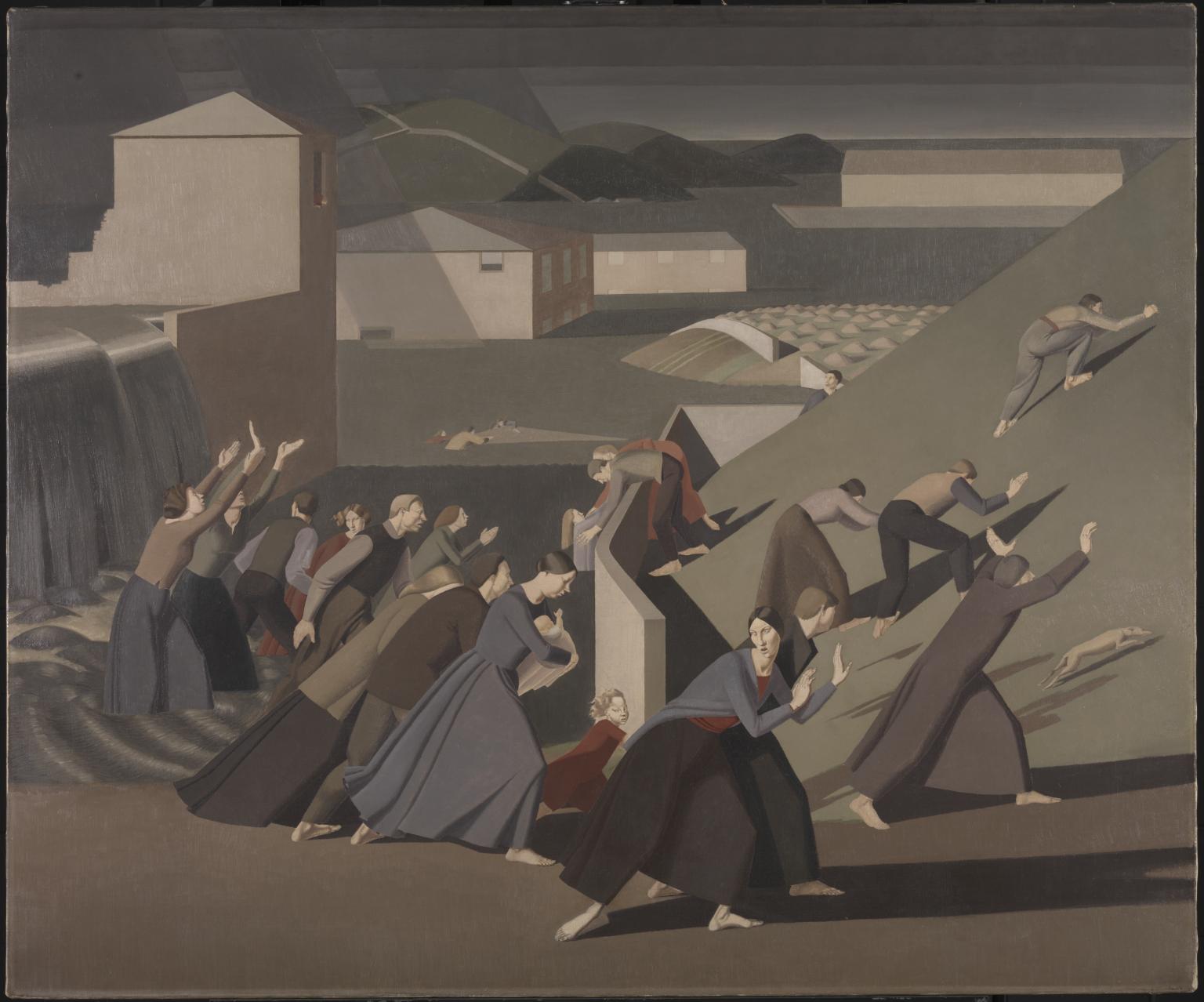
Winifred Knights, The Deluge 1920
Knights was one of several British artists who participated in a revival of religious imagery in the 1920s, while retaining some elements of a modern style. The theme of this work is the Old Testament Flood. In the foreground, people flee the rising waters towards the high ground, while Noah's ark floats calmly in the distance to the right. The frequent use of the word 'deluge' as a metaphor for the all-engulfing First World War would have given the painting a contemporary resonance.
Gallery label, September 2004
11/30
artworks in Reality and Dreams

Eileen Agar, Marine Object 1939
For Agar, the unexpected juxtaposition of found objects was ‘a form of inspired correction, a displacement of the banal by the fertile intervention of chance or coincidence’. In Marine Object she brings together part of a Greek amphora that she retrieved from a fisherman’s net in the south of France with crustaceans and flotsam gathered on a beach two years earlier, and a ram’s horn from Cumbria. Agar described the making of Marine Object as ‘short work... though it took me and the amphora a long time to attempt such a conjunction!’
Gallery label, January 2016
12/30
artworks in Reality and Dreams
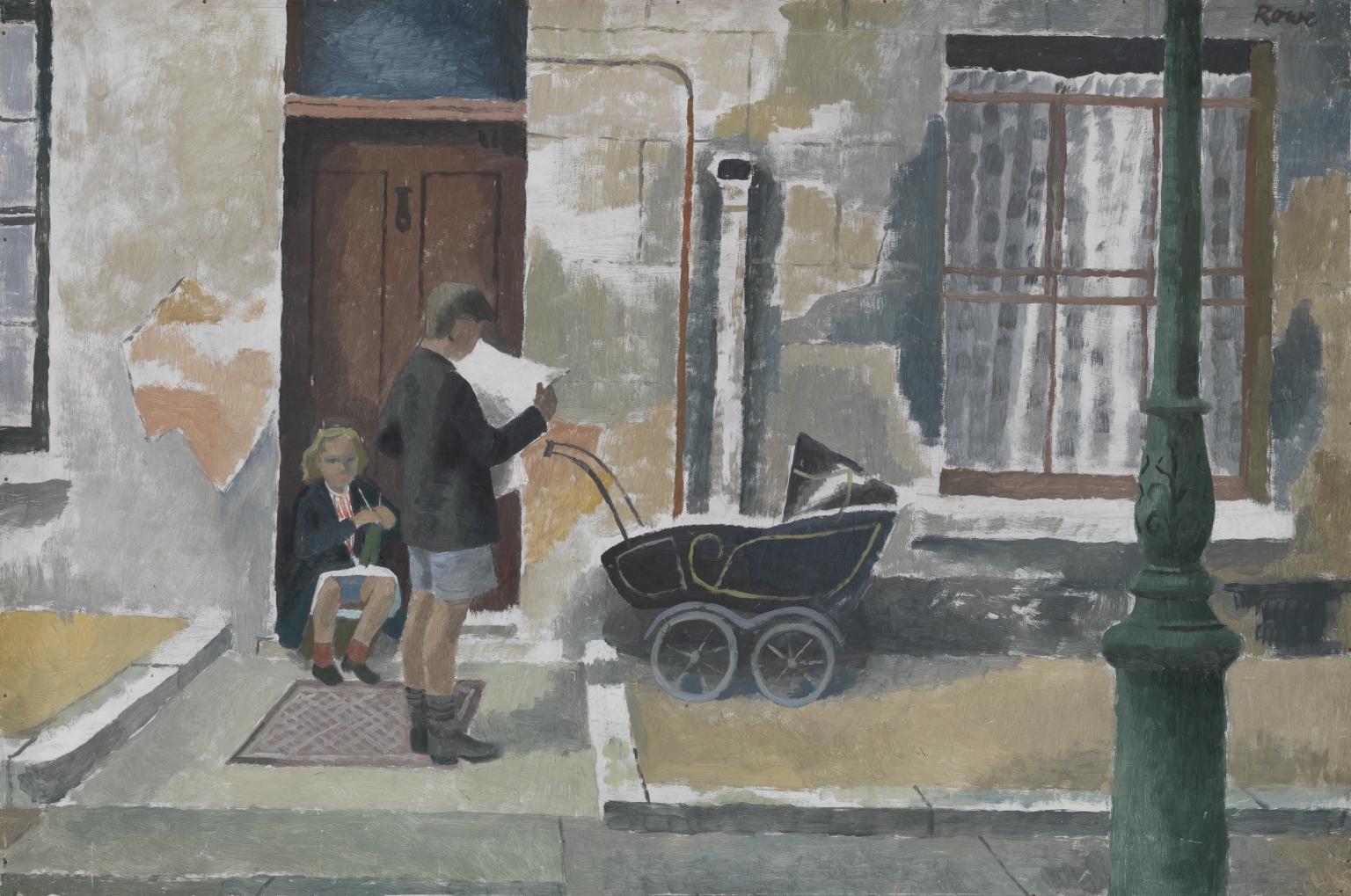
Cliff Rowe, Street Scene Kentish Town c.1931
13/30
artworks in Reality and Dreams
Sorry, no image available
William Roberts, Portrait of Hélène Yellin c.1923
14/30
artworks in Reality and Dreams
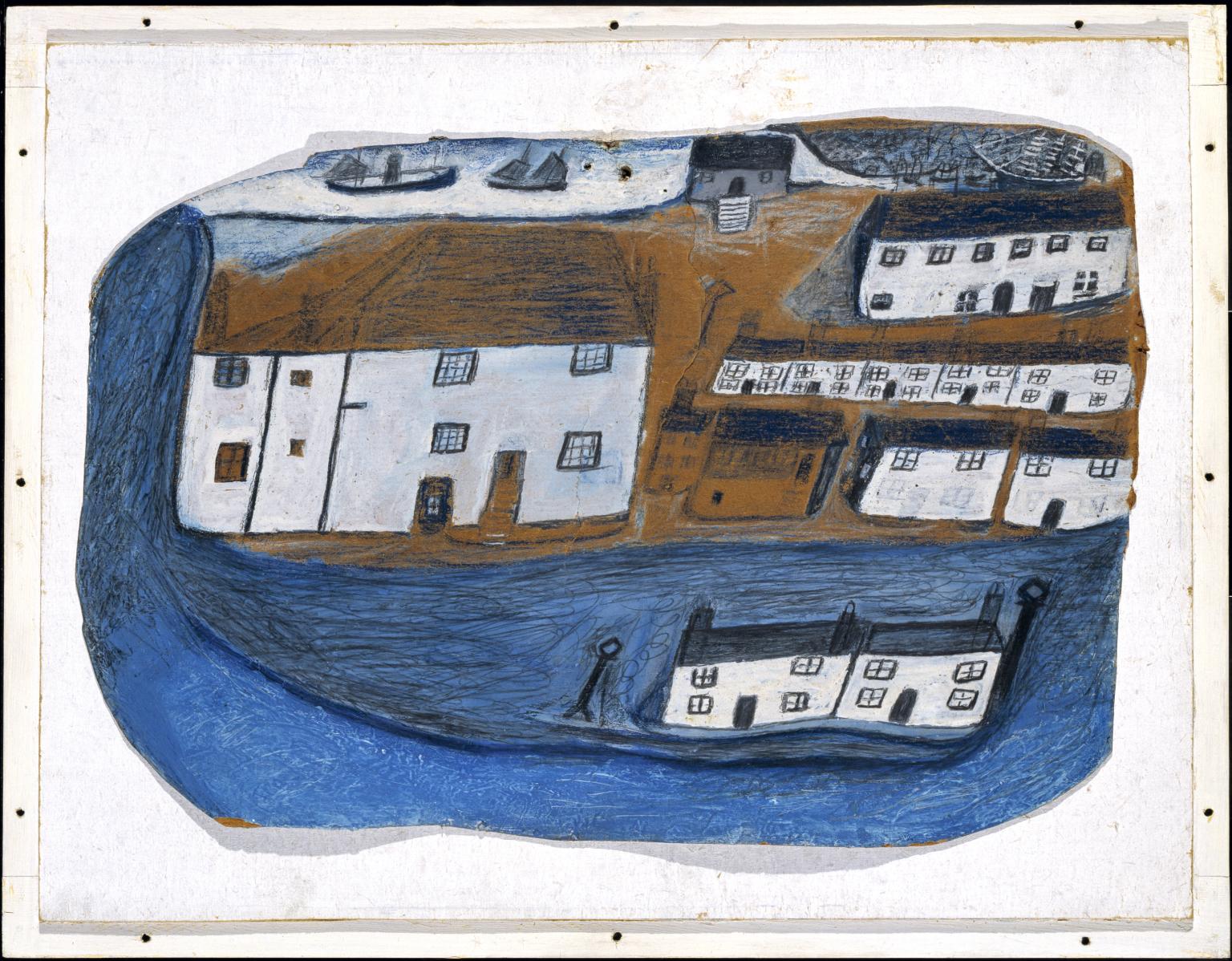
Alfred Wallis, St Ives c.1928
Wallis had worked as seaman, ice cream vendor and scrap merchant before he took up painting as a hobby in his retirement. He lived in St Ives, Cornwall, a fishing community and artists’ colony. There he encountered the painters Ben Nicholson and Christopher Wood and his work was shown with theirs in London. Most of his paintings are of his local environment or of places and events remembered from his past.
Gallery label, July 2017
15/30
artworks in Reality and Dreams
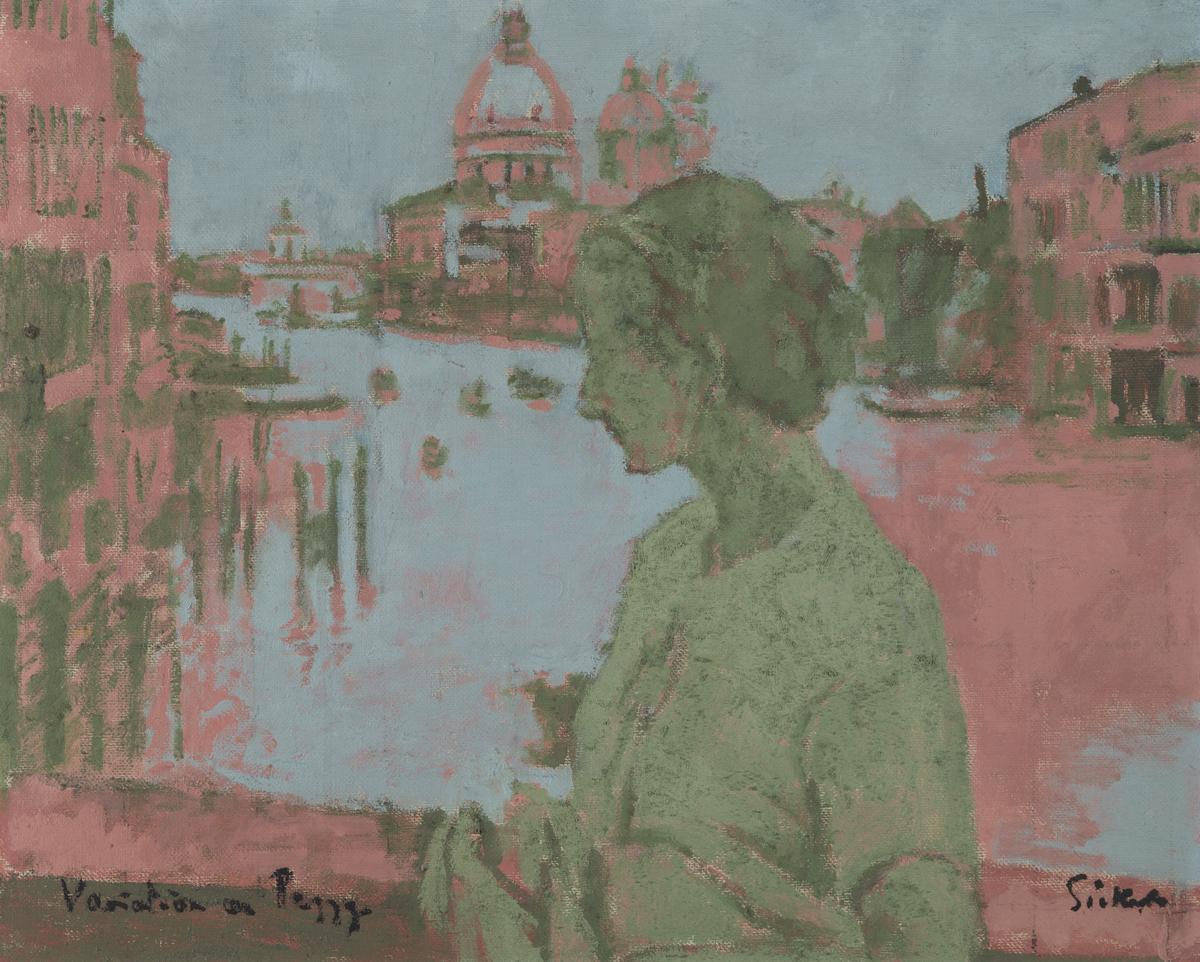
Walter Richard Sickert, Variation on Peggy 1934–5
Sickert loved the theatre. He had admired the actress Peggy Ashcroft from one of her earliest stage appearances, as Desdemona in Shakespeare's tragedy Othello in 1930. This portrait was painted when Sickert was in his seventies; at this stage he often chose his subjects from newspaper images, in this case a photograph from the Radio Times of the actress on holiday in Venice. The painting's dry, grainy texture, and non-naturalistic, shadowless colouring puts a distance between background, figure and viewer. This painting combines two of Sickert's favourite themes: Venice and theatre.
Gallery label, August 2004
16/30
artworks in Reality and Dreams
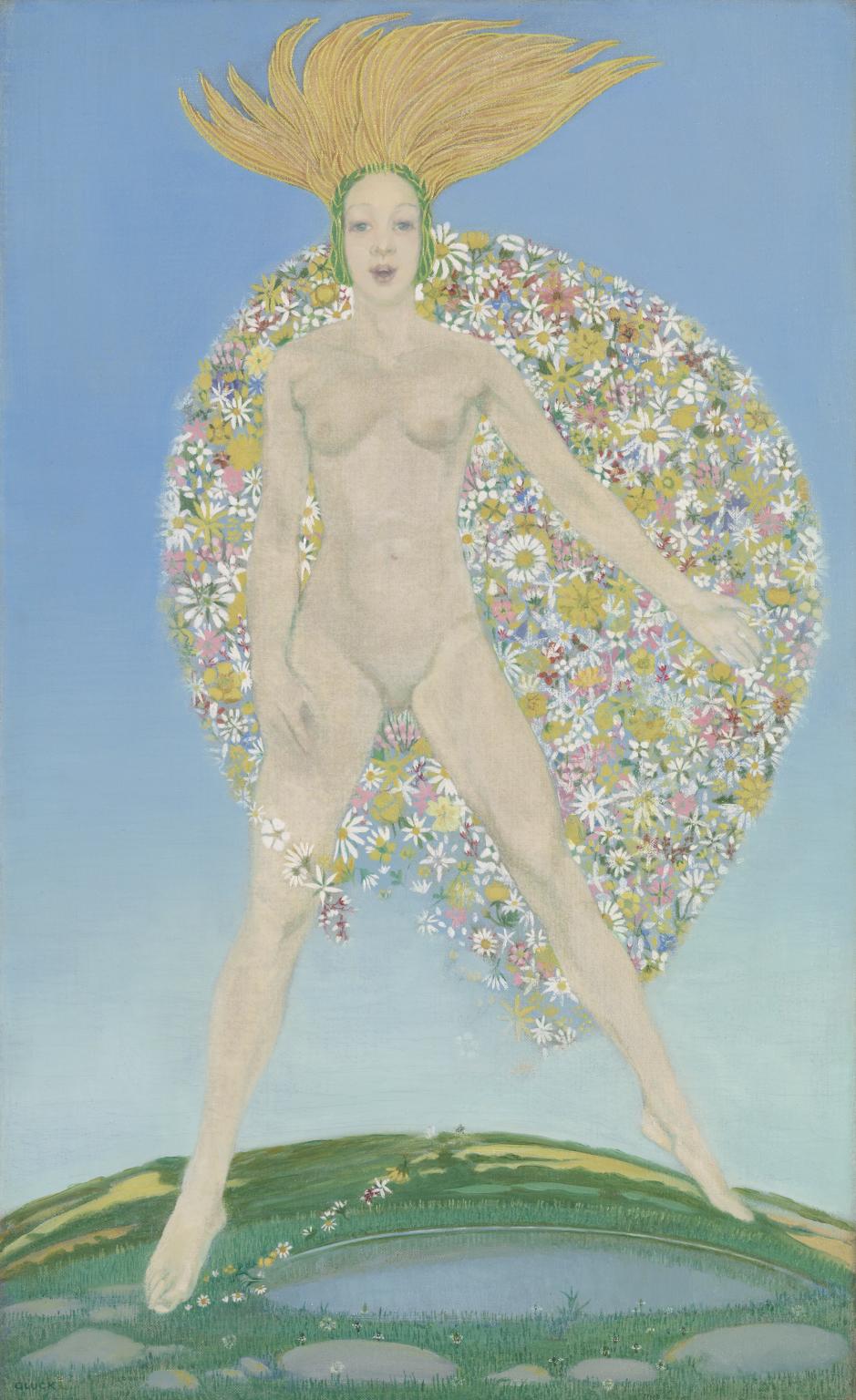
Gluck, Flora’s Cloak c.1923
Flora’s Cloak c.1923 is a portrait-format oil painting in the centre of which is a full-length figure of a nude young woman set on a pale blue ground. The figure’s legs and feet are pointed towards the lower corners of the canvas, so that she seems to be lightly floating in space. Her right arm hangs down and rests in front of her right thigh, while her left extends out from her core at forty-five degrees, with her palm open to the viewer. The geometrical spacing of her limbs recalls the form of Leonardo’s Vitruvian Man c.1490 (Gallerie dell’Accademia, Venice). Her nude figure is youthful but toned, with pale pink skin, and she wears a headdress reminiscent of straw or yellow flames attached to a green band framing her face. Her face is also youthful, with blue eyes and an open expression of raised eyelids and a slightly parted mouth. Behind her back and outstretched left hand is a billowing cloak of small spring flowers, including daisies painted in white and light green, with others rendered with darker green stems, and petals in light pink, and more occasional touches of deep red, light blue and purple. Like the figure, these flowers seem to hover or to move slowly in the air; together they form a rounded shape with a definite edge, cloaking her back, as well as a single trail that circles loosely as a narrow band of white flowers around her right thigh.The light blue ground slightly pales towards the figure’s feet and towards the centre of the composition, creating the impression of a portion of an airy cloudless sky on a bright day. At the figure’s base is a top-section of a rounded globe or mound of earth, covering approximately the painting’s lower fifth, which extends to the right, left and lower edges of the composition. In the foreground of this earth are some wide rounded pebbles, varying in size, before a circular pool of water, all set within a field of short green grass. Behind this a more distant landscape of yellow and green fields is visible. The pool is described as a reflection of blue sky and a rim of reflected green grass. The figure’s toes extend towards this earthly surface and her right foot appears to touch lightly the grassy bank. In this area a trail of smaller flowers has been painted in a small circle near her foot and then receding towards the distant earth. This might suggest that the figure, with her cloak of flowers, has brought them to the earth with her presence or touch.The painting’s title, Flora’s Cloak, refers to the Roman mythological character Flora, goddess of flowers and spring and symbol of fertility, youth and the renewal of life. Gluck’s treatment of this theme in this way particularly recalls the figure of the same character in Sandro Botticelli’s Primavera c.1470–80 (Uffizi Gallery, Florence), who looks to the viewer while scattering flowers over the ground, clothed in a billowing floral grown. Flora’s Cloak has also previously been referred to as ‘Primavera’. Botticelli’s example would have been well-known to Gluck and available in reproduction, as would also have been his full-length female nude in The Birth of Venus c.mid-1480s (Uffizi Gallery, Florence). Both Gluck and Botticelli’s paintings are allegorical visual expressions based on the personification of Spring. While Botticelli’s larger composition has been described as a depiction of the progress of the spring season over time, Gluck’s depiction catches the goddess at an extended moment of arrival or reign. In one textual description of the myth by Ovid, it is described how a naked wood nymph attracted the first wind of Spring, Zephyr; she was ravished and flowers sprang from her mouth, transforming her into Flora, the goddess of flowers. In this source the reader is told that ‘till then the earth had been but of one colour’, namely green (Ovid, Fasti, Book 5, 2 May, original 8 AD, trans. James G. Frazer, 1931). Flora’s Cloak is thought to be the only painting by Gluck of a nude figure. It was painted during the artist’s late twenties, after Gluck had returned to north London (where the artist was born, to an affluent Jewish family) following a close attachment to the landscape and artistic scene of West Cornwall. During the early 1920s Gluck lived and worked in London, first living in a flat in Finchley Road and working from a two-room studio in Earl’s Court; from 1926 the artist owned Bolton House in Hampstead, which had its own studio. Throughout Gluck spent summers in Lamorna, Cornwall, and continued an association with the Newlyn School of Painters. In the countryside Gluck was especially struck by the effect of light upon the sky and landscape, writing later how ‘a landscape is chameleon to the light’ (Gluck, ‘Notes on Landscape Painting’, undated [1940], quoted in Souhami 1988, p.42). A work comparable to Flora’s Cloak, as a symbolic expression of the wonder of the natural world, is a landscape based on Cornwall showing broad beams of light emanating from the sky (Pheobus Triumphant c.1920, private collection). Flora’s Cloak was included in Gluck’s first solo exhibition, at the Dorien Leigh Galleries in South Kensington in 1924. A show of fifty-seven pictures that proved a commercial success, this led to a second solo exhibition two years later, called Stage and Country, at the Fine Art Society, London.Gluck continued to exhibit with the Fine Art Society. In 1932 Gluck designed and patented ‘the Gluck Frame’, a three-stepped frame painted the same colour as the wall and intended to incorporate the picture into the wall visually, creating greater unity between her paintings and the surrounding room. Flora’s Cloak is framed in a stamped ‘Gluck Frame’, which was probably fitted during the 1930s. It was also in 1932 that Gluck, openly queer, met a new partner, the florist Constance Spry. They were introduced that January via an arrangement of flowers that had been delivered to Gluck that Gluck had decided to paint. Not only was a new relationship sparked, but Gluck also made a significant number of flower paintings that show how the artist’s sensibility aligned with Spry’s preference for well-spaced white floral arrangements that focused attention on the interplay between light, shade, colour and shape. During this time Spry came to own Flora’s Cloak, which hung above the fireplace in her Kent home, Park Gate, where Gluck frequently spent weekends. It is also said to have hung on the walls of Spry’s shop ‘Flower Decoration’, probably at 64 South Audley Street in Mayfair (which her business occupied from 1934 to 1960). Though the relationship ended in 1936, Gluck continued to paint floral arrangements into the early 1940s. Further reading Drawing & Design: Incorporating the Human Form, vol.4, series VI, November 1924, illustrated p.205.Diana Souhami, Gluck: Her Biography, London, 1998, pp.54-62, detail reproduced p.55.Amy de la Haye and Martin Pel, eds., Gluck: Art and Identity, New Haven and London, 2017, p.90, reproduced p.92.Rachel Rose SmithFebruary 2019
17/30
artworks in Reality and Dreams
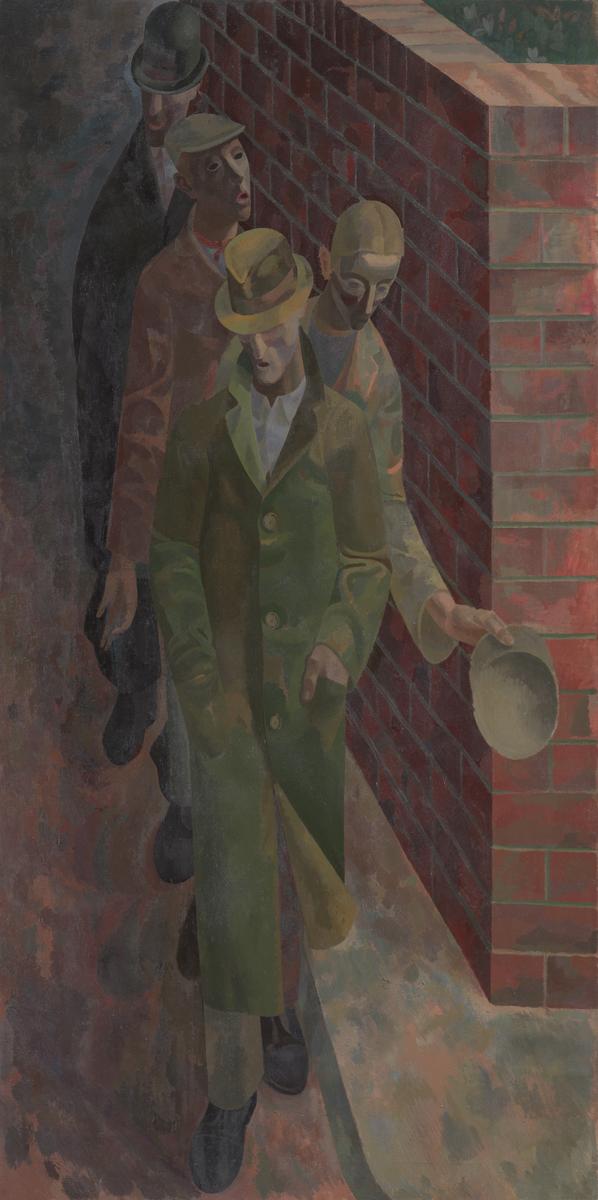
Reginald Brill, Unemployed c.1934–6
Unemployed c.1934–6 is a large oil painting that depicts four men in shabby overcoats and hats walking in a line alongside a brick wall and pavement. The second of the men holds his cap in his hand as if about to ask for money and the man behind him appears to be chanting or singing, implying that they may be part of a larger group. The work is painted in a sombre palette of browns, greys and dark reds. The subject of the work is the Hunger Marches that took place in Britain in the 1930s and which Brill witnessed first-hand, an experience that deeply affected him. Although the Jarrow March of 1936 is the most famous of these, there were many others including the ‘National Unemployed March to London’ in 1932. Brill first started working on this subject matter in 1933 and showed another painting titled Unemployed in his exhibition at the Leicester Galleries in London in 1933.
18/30
artworks in Reality and Dreams
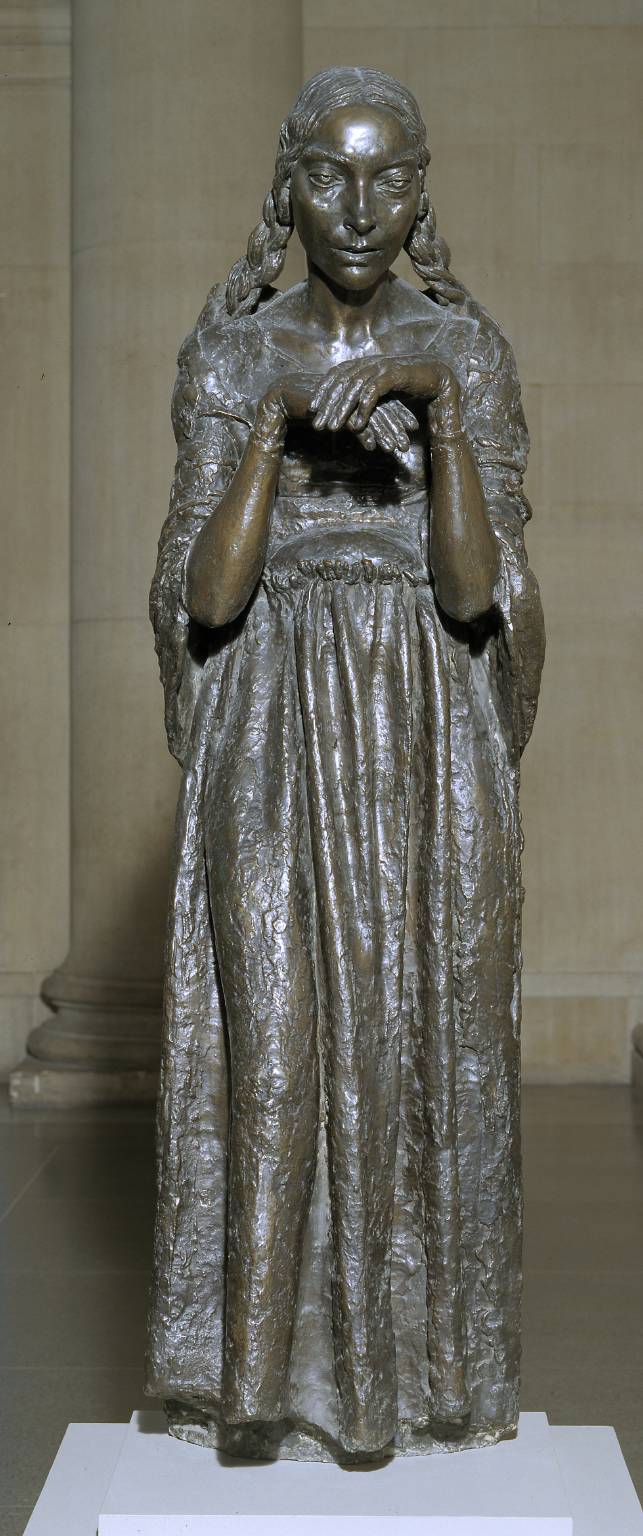
Sir Jacob Epstein, The Visitation 1926
This life-size figure was intended to be one of a pair, never completed, called 'The Visitation'. This was an event recorded in the Bible, where the Virgin Mary visits her cousin Elizabeth to share with her the news that she is to give birth to Jesus. Epstein described this figure as expressing ' a humility so profound as to shame the beholder who comes to my sculpture expecting rhetoric or splendour of gesture'. When he first exhibited it he called it 'A Study' so as to diguise its content.
Gallery label, August 2004
19/30
artworks in Reality and Dreams
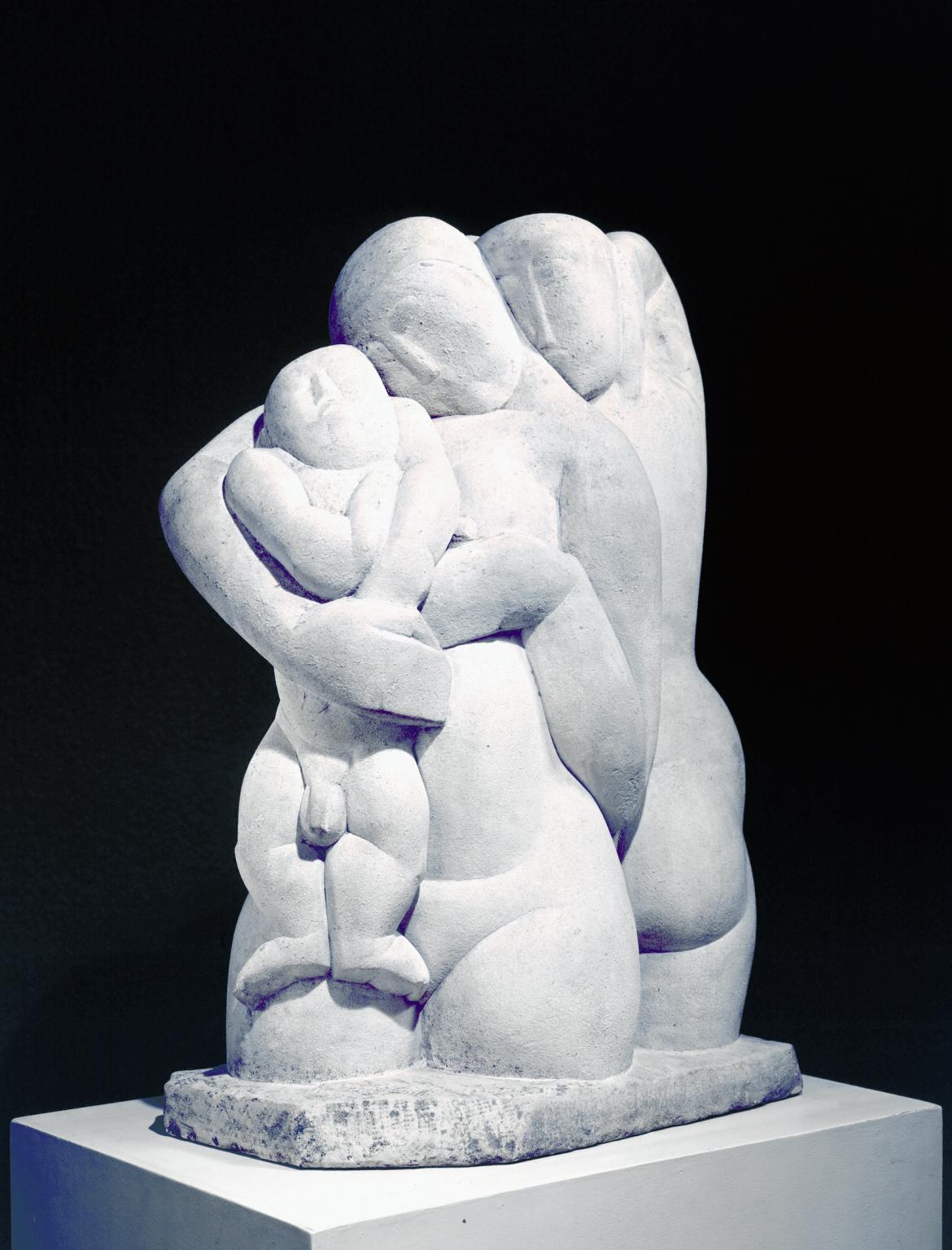
Frank Dobson, The Man Child 1921
Dobson trained as both a painter and sculptor, but concentrated on sculpture after active service in the First World War. Like many of his contemporaries, he found inspiration for his work in the ethnographic collections of the British Museum. He particularly admired carvings from the Congo in Africa. Such interest in what had been considered ‘less civilised’ cultures became more widespread after the ‘sophisticated’ destruction of the war.Here, in the wake of conflict, Dobson returns to fundamental human relationships. The manchild of the title melds with two female figures who seem to embody maternal protection expressing both joy and fear for the new life.
Gallery label, July 2007
20/30
artworks in Reality and Dreams
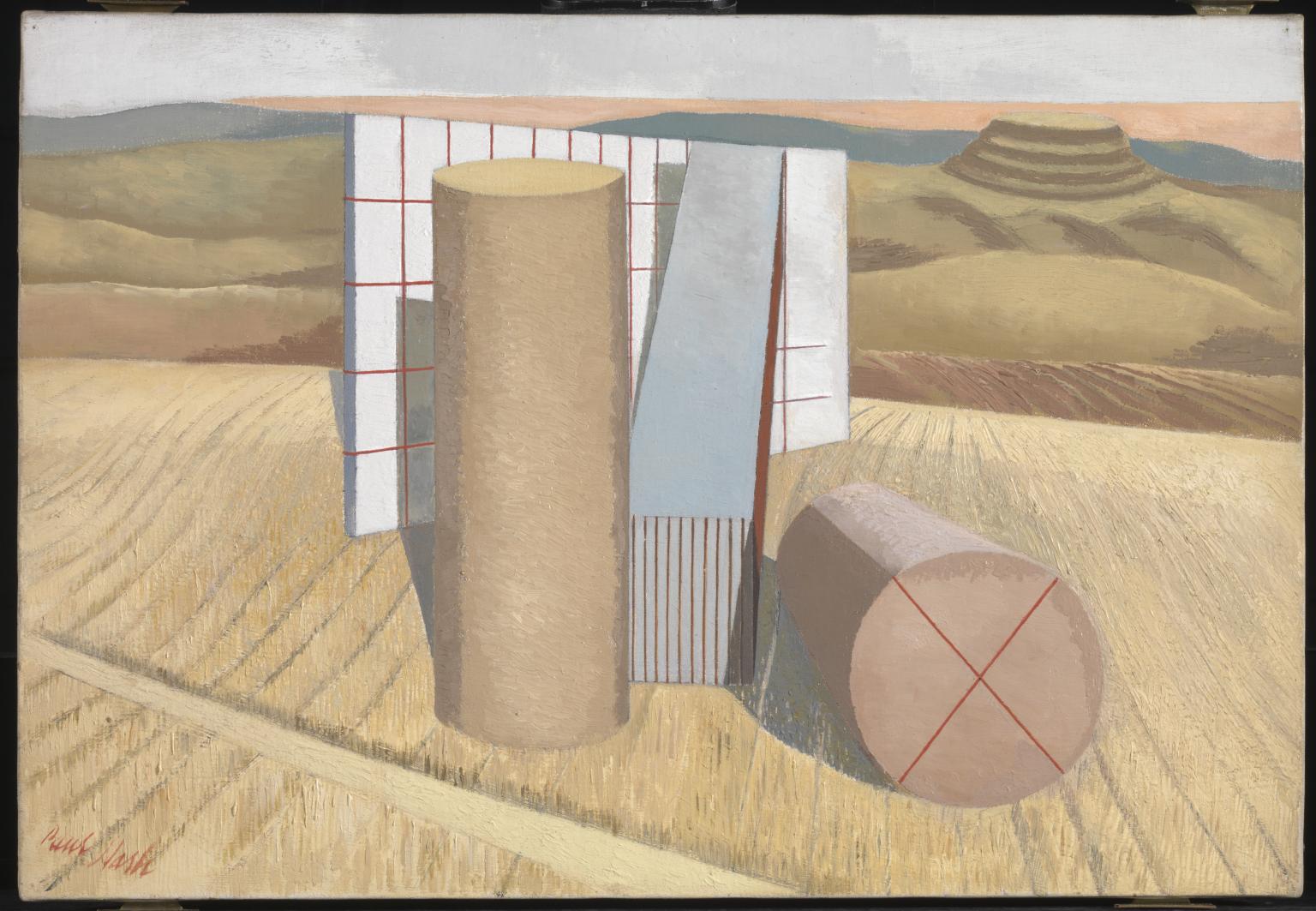
Paul Nash, Equivalents for the Megaliths 1935
‘Megaliths’ are great standing stones, the remains of ancient temples in places such as Stonehenge; this work was inspired by the stones at Avebury, on the Wiltshire Downs. Here Nash brings together Britain’s most advanced cultural objects with its most ancient: the geometric forms are similar to those found in contemporary abstract sculpture, but are also ‘equivalents’ for prehistoric standing stones. Nash had an enduring fascination with the mystical qualities of inanimate objects. The abstract forms draw on the emotional presence of ancient monuments, integrated with the landscape, but also provide a powerful element of abstract design.
Gallery label, September 2004
21/30
artworks in Reality and Dreams
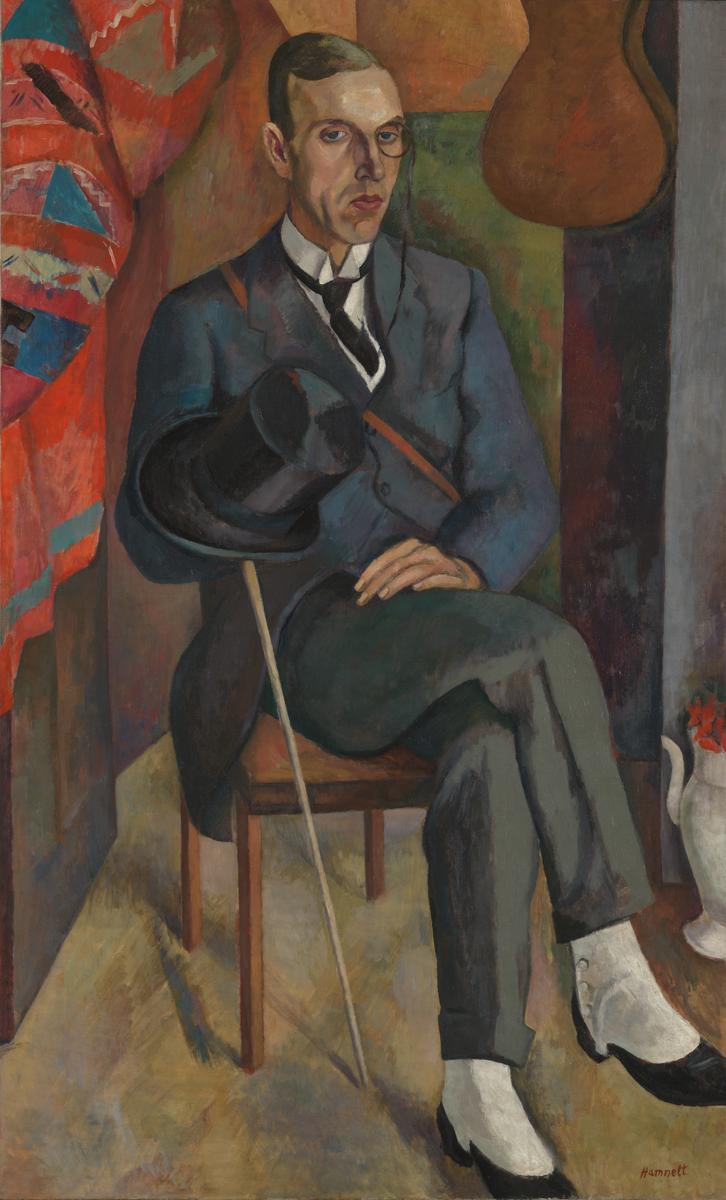
Nina Hamnett, A Gentleman with a Top Hat (George Manuel Unwin Esq) 1921
22/30
artworks in Reality and Dreams
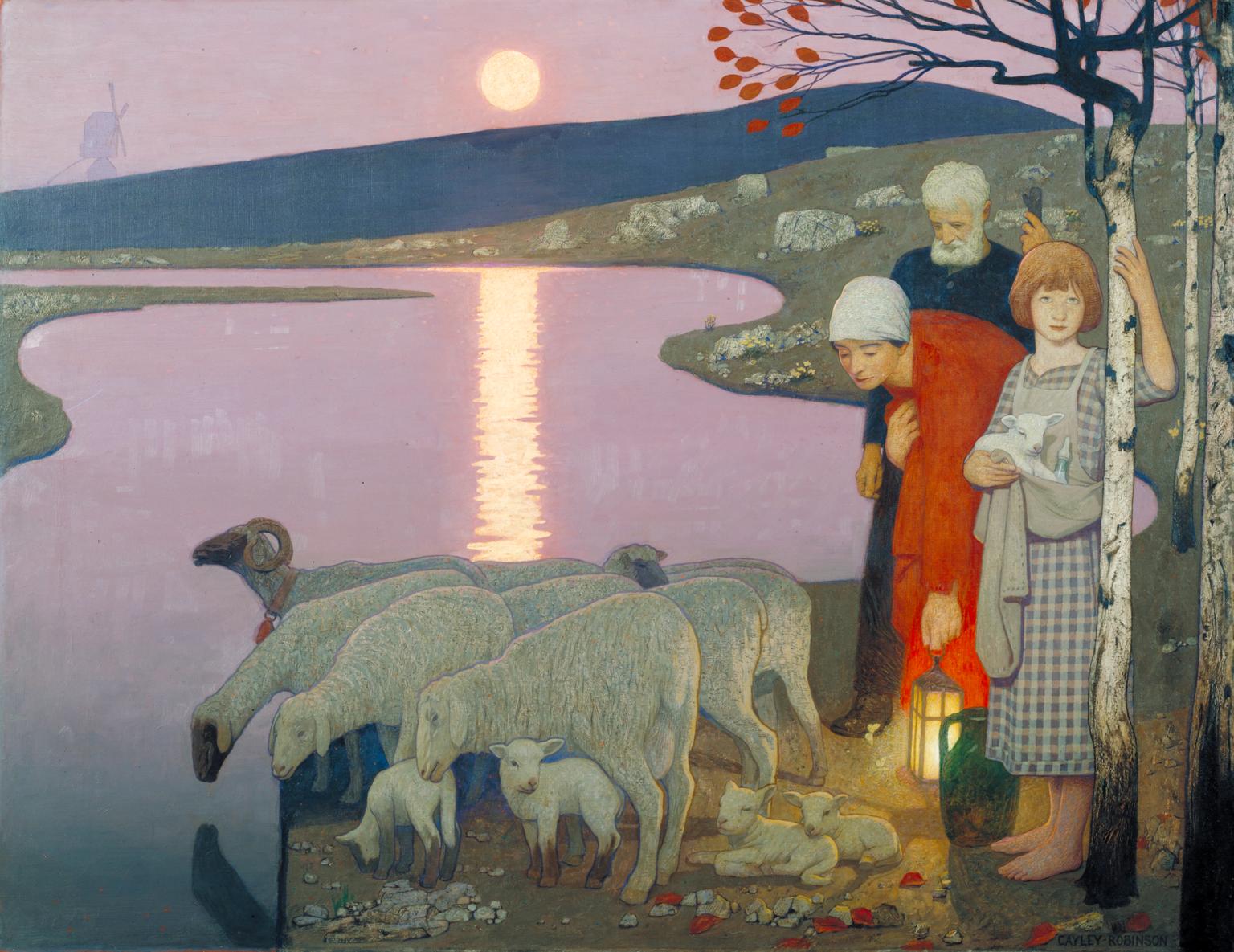
Frederick Cayley Robinson, Pastoral 1923–4
23/30
artworks in Reality and Dreams
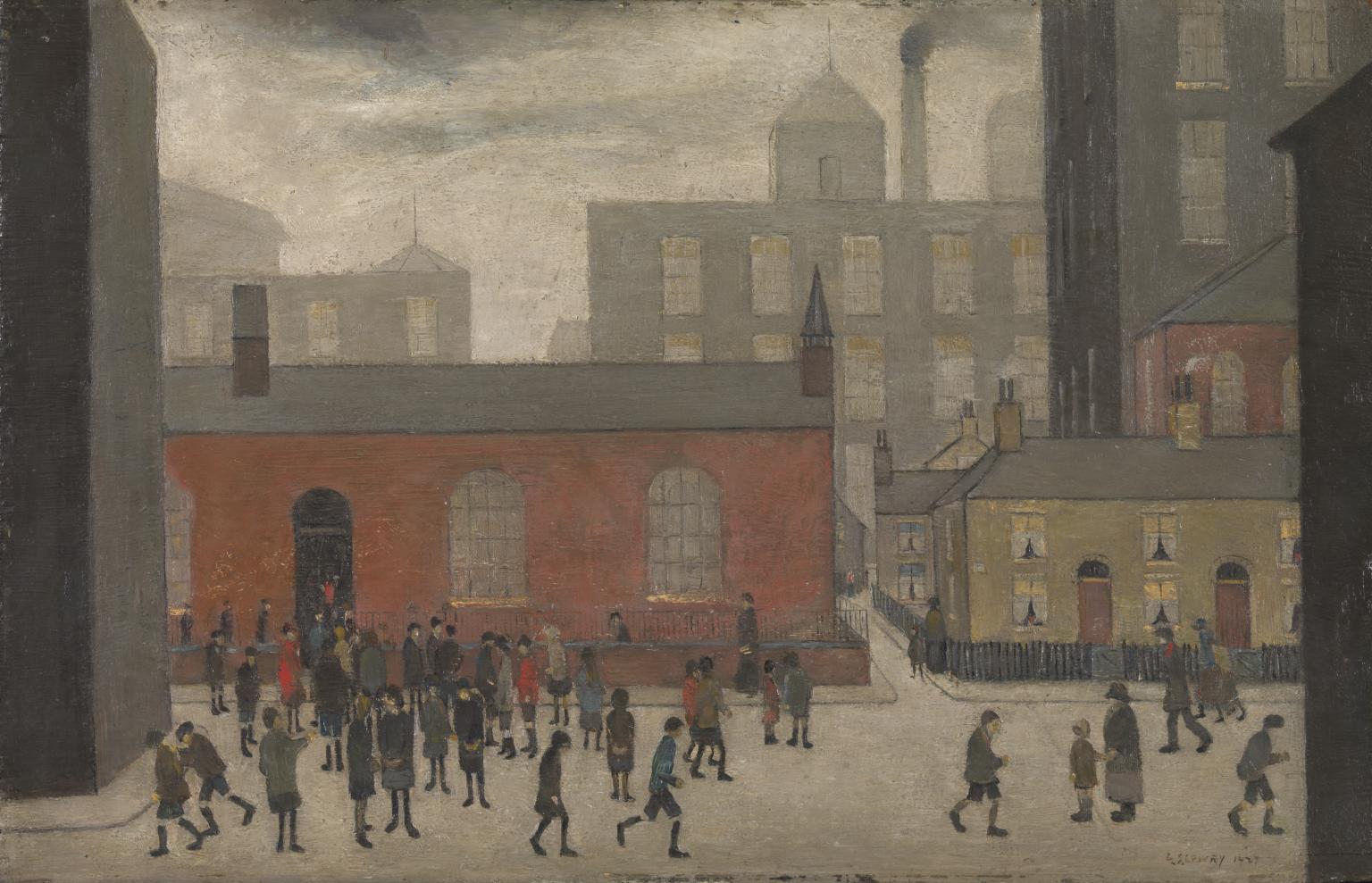
L.S. Lowry, Coming Out of School 1927
Like many of Lowry's pictures this is not a depiction of a particular place, but is based on recollections of a school seen in Lancashire. Lowry's combination of observation and imaginative power often produced images which capture a deeply felt experience of place, with which others could identify. For example, in 1939 John Rothenstein, then Director of the Tate Gallery, visited Lowry's first solo exhibition in London and later wrote: 'I stood in the gallery marvelling at the accuracy of the mirror that this to me unknown painter had held up to the bleakness, the obsolete shabbiness, the grimy fogboundness, the grimness of northern industrial England.' This work was then purchased by the Trustees.
Gallery label, April 1994
24/30
artworks in Reality and Dreams
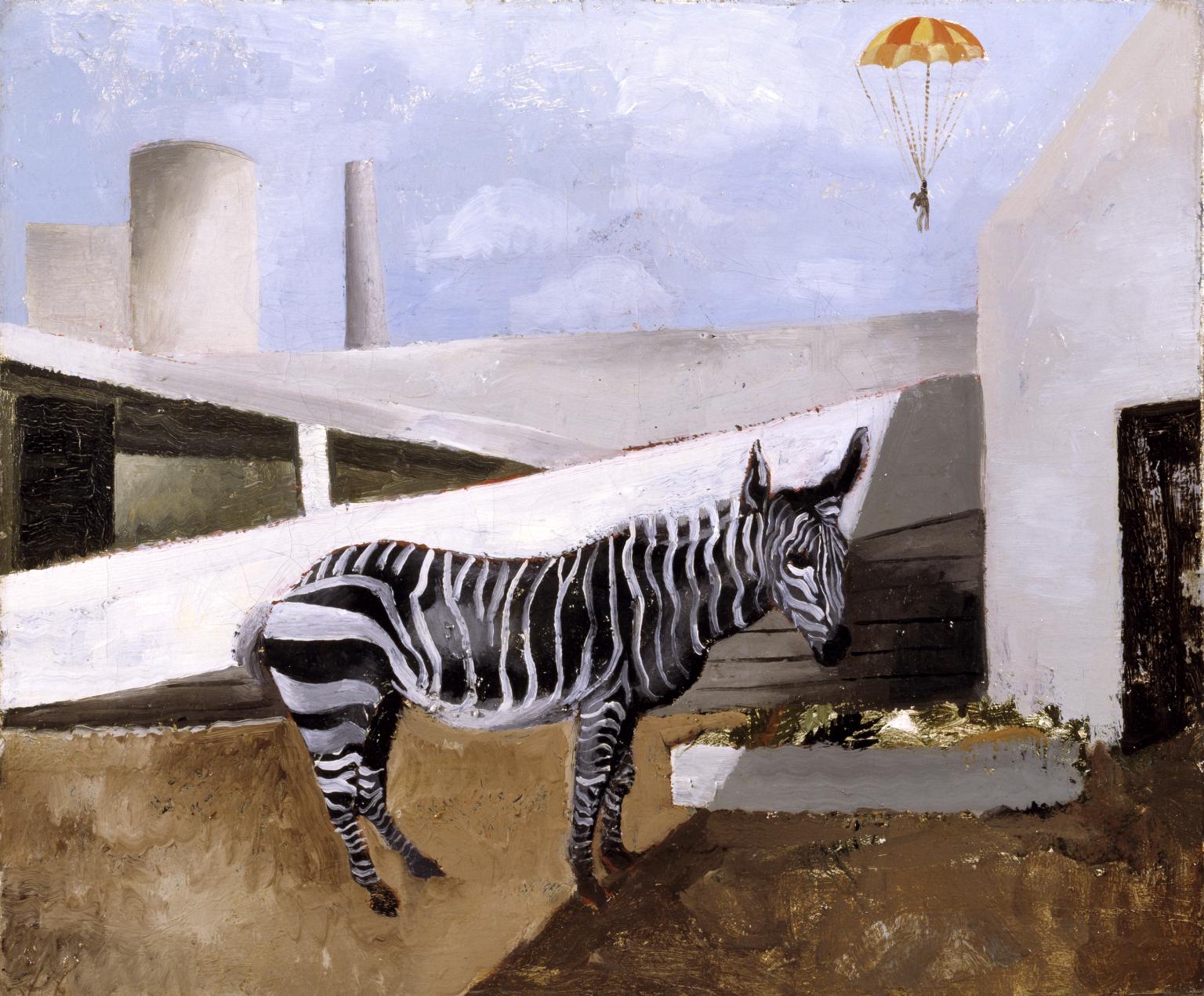
Christopher Wood, Zebra and Parachute 1930
A friend of the Surrealist poet René Crevel, Wood made a small number of paintings that seem to reflect the movement's harnessing of the unexpected. His placement of a zebra outside Le Corbusier’s modernist house, the Villa Savoie (then still under construction), suggests a deliberate confrontation of the surreal and the functional styles that were then dominant in Paris. The image is made more perplexing by the figure of the parachutist. This was one of Wood's last works: in a paranoid state, he fell under a train in August 1930.
Gallery label, July 2007
25/30
artworks in Reality and Dreams
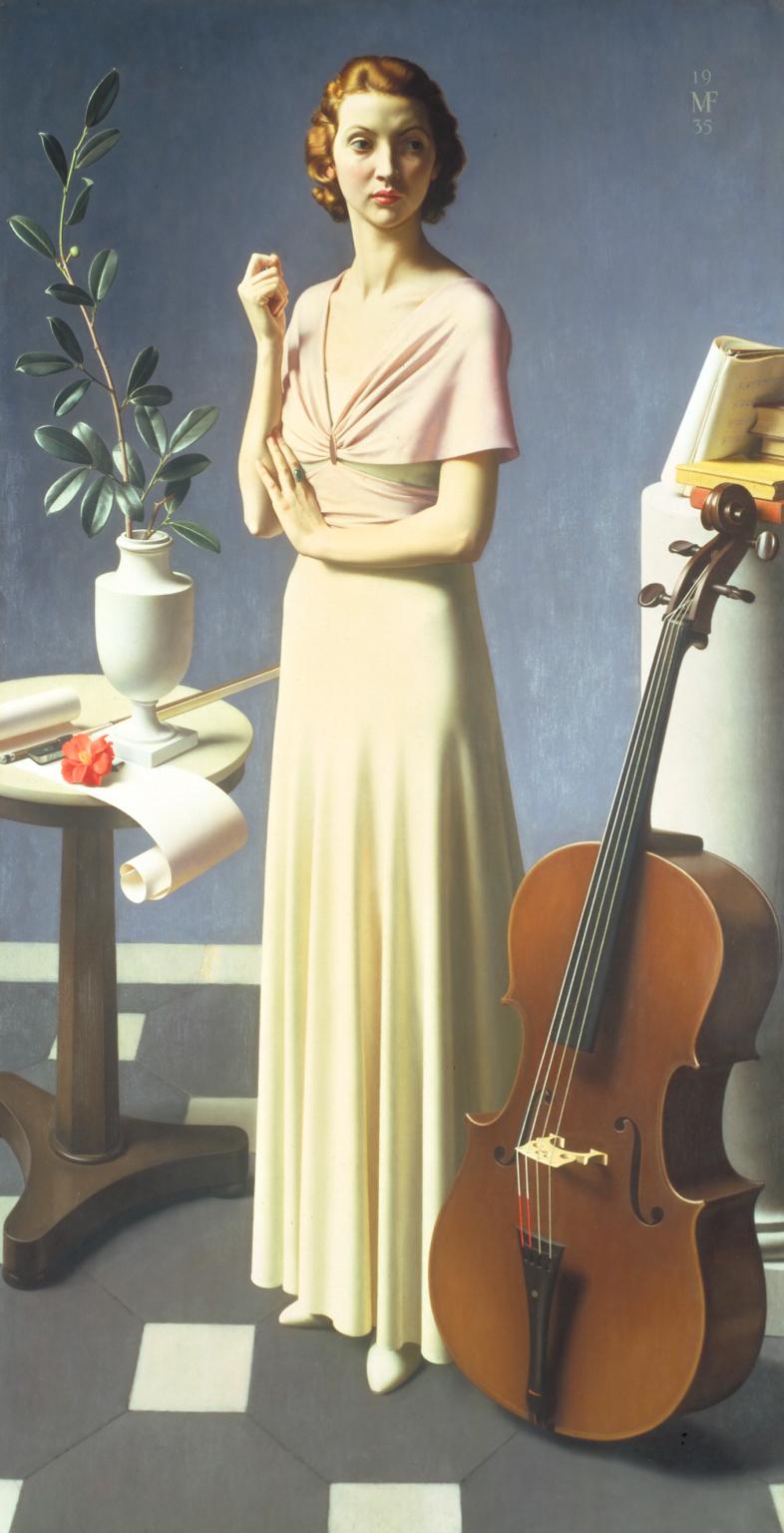
Meredith Frampton, Portrait of a Young Woman 1935
Frampton painted the sitter, Margaret Austin-Jones, standing next to a cello. He noted that, as she was very musical, the cello was an 'appropriate symbol.' Frampton said that he made this painting 'to celebrate an assembly of objects... beautiful in their own right’. Frampton's mother made the dress Margaret is wearing in the painting. The white vase on the table in the background was designed by Frampton. This painting relates to full-length portraits of women, associated with the work of earlier artists. However the clarity and precision of Frampton’s painting style gives this work a modern feeling.
Gallery label, August 2020
26/30
artworks in Reality and Dreams
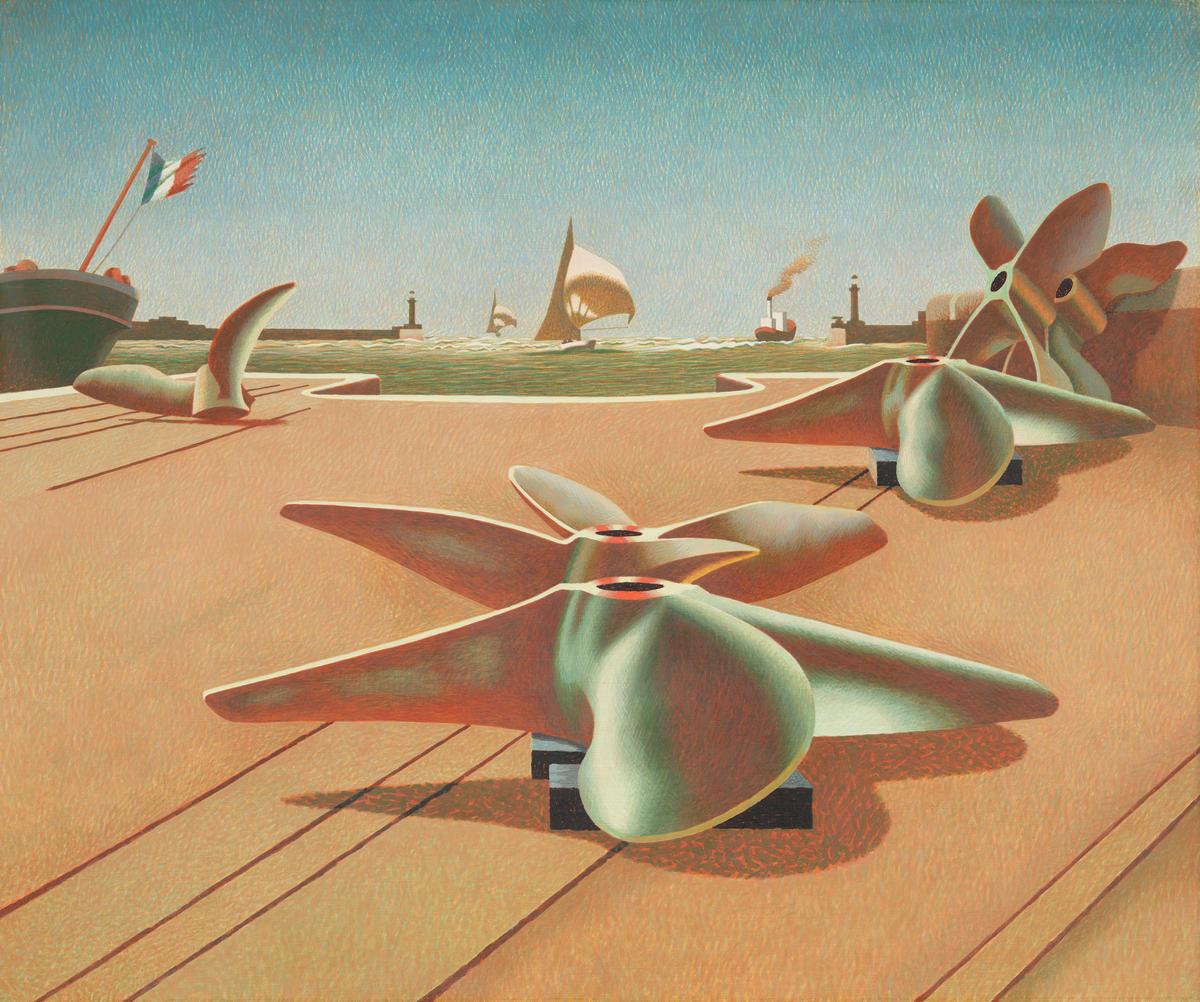
Edward Wadsworth, Bronze Ballet 1940
This harbour scene is based on Le Havre in northern France. Although this is a peaceful scene, it was painted during the early years of the Second World War, in Maresfield in Sussex. From there, Wadsworth could hear the bombing of French ports by the German forces.Wadsworth painted many collections of marine objects like this. He was interested in animism – giving life to inanimate objects. Here the forms of the ships’ propellers suggest movement, or a dance, while also hinting at the function they will perform out at sea.
Gallery label, April 2019
27/30
artworks in Reality and Dreams
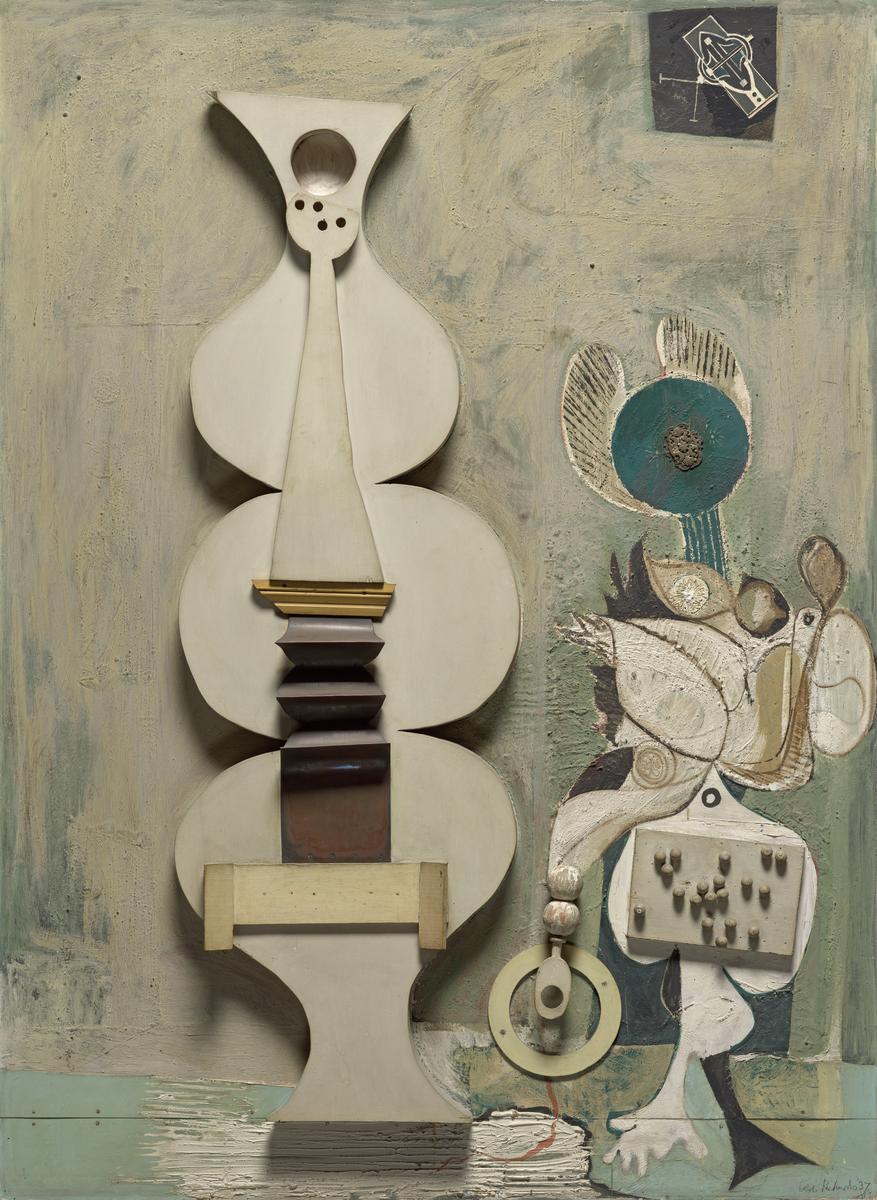
Ceri Richards, Two Females 1937–8
The International Surrealist Exhibition was held at the Burlington Galleries in the summer of 1936, and for a brief moment, in the words of André Breton, London was ‘the centre of the Surrealist universe’. Richards exhibition gave him an opportunity to study important works by Ernst, Picasso and Miro, among others. Subsequently a pronounced erotic sensibility became apparent in Richards’s own loosely surreal work. Two representations of the female form are contrasted in this relief. On the right, virginal, though budding and seductive, and on the left, fulsome and latently sexual.
Gallery label, September 2016
28/30
artworks in Reality and Dreams
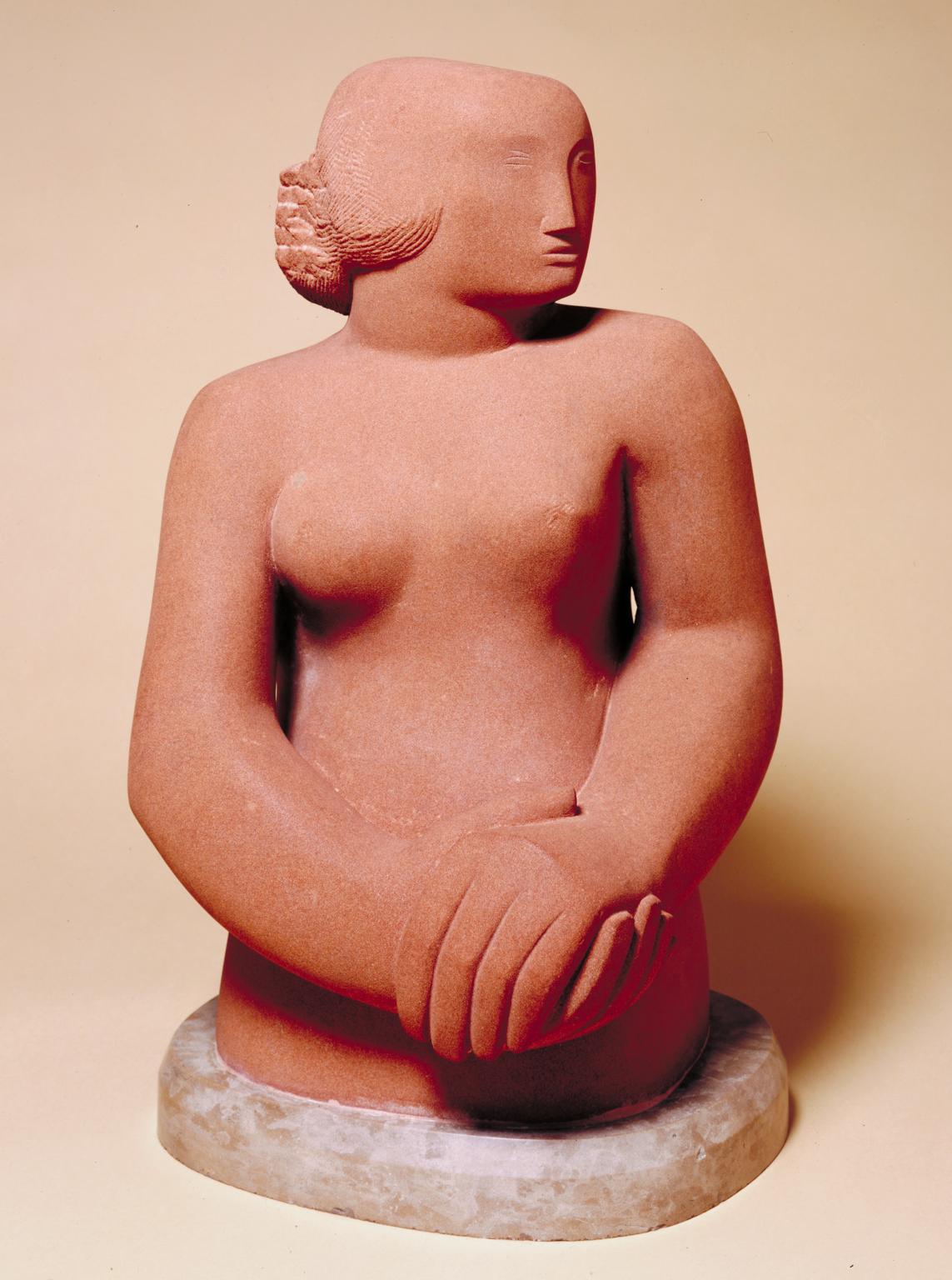
Dame Barbara Hepworth, Figure of a Woman 1929–30
Hepworth was one of a number of sculptors who returned to the handcraft of carving. The resulting immediacy of the artist’s relationship to her material was crucial. She described her process as an ‘effort to find a personal accord with the stones...I was fascinated by the kind of form that grew out of each sculpture, and by the kind of form that grew out of achieving a personal harmony with the material’.Like others, she sourced a wide range of indigenous British stones. This figure is made of Corsehill stone, a red sandstone quarried in Dumfriesshire.
Gallery label, July 2007
29/30
artworks in Reality and Dreams
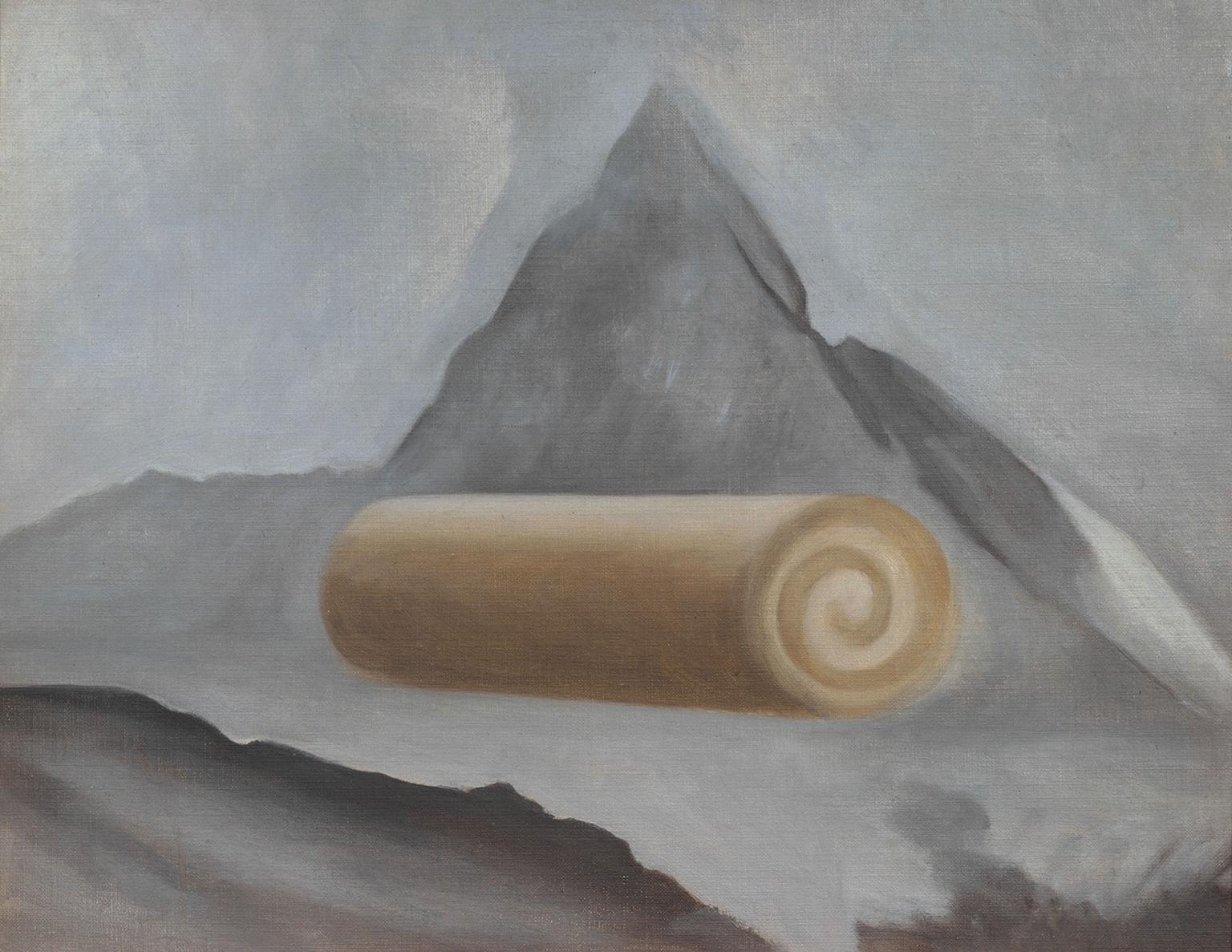
Humphrey Jennings, Swiss Roll 1939
30/30
artworks in Reality and Dreams
Art in this room
Sorry, no image available



Sorry, no image available








Sorry, no image available
















You've viewed 6/30 artworks
You've viewed 30/30 artworks
Responses
-
Unknown artist Tropic Reveries by Una Marson
date not knownOn display at Tate Britain part of Historic and Modern British Art
